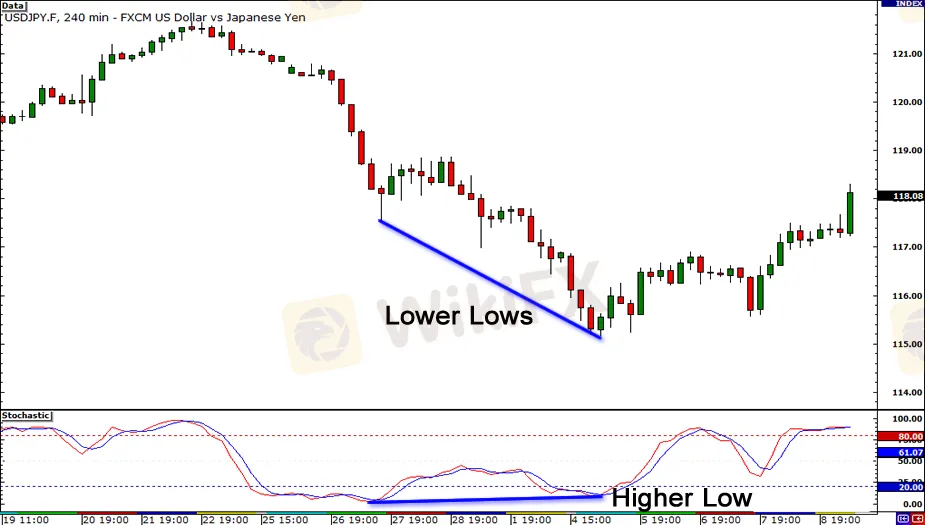简体中文
繁體中文
English
Pусский
日本語
ภาษาไทย
Tiếng Việt
Bahasa Indonesia
Español
हिन्दी
Filippiiniläinen
Français
Deutsch
Português
Türkçe
한국어
العربية
Divergence Cheat Sheet
Abstract:Divergence is a well-known concept in technical analysis that describes when the price is moving in the opposite direction of a technical indicator. Note that divergence is not a trading signal but rather an indicator.
Have you filled on learning how to trade divergences? Le'ts have a review of it!
Divergence is a well-known concept in technical analysis that describes when the price is moving in the opposite direction of a technical indicator. Note that divergence is not a trading signal but rather an indicator.
There are two types of divergences:
Regular divergence
Hidden divergence
Each type of divergence will contain either a bullish bias or a bearish bias. Because you‘ve all be studying hard and not been cutting class, we’ve decided to help y‘all out (cause we’re nice like that) by giving you a Divergence Trading Cheat Sheet to help you figure out regular and hidden divergences immediately.
Regular Divergence
Regular divergences can help you collect a big chunk of profit because youre able to get in right when the trend changes. Regular divergences signal a possible trend reversal
| BIAS | PRICE | OSCILLATOR | DESCRIPTION | EXAMPLE |
| Bullish | Lower Low | Higher Low | Indicates underlying strength. Bears are exhausted. Warning of a possible trend direction change from a downtrend to an uptrend. |  |
| Bearish | Higher High | Lower High | Indicates underlying weakness. The bulls are exhausted. Warning of a possible trend direction change from an uptrend to a downtrend. |  |
Hidden Divergence
Hidden divergences can help you ride a trade longer resulting in bigger-than-expected profits by keeping you on the correct side of a trend.
| BIAS | PRICE | OSCILLATOR | DESCRIPTION | EXAMPLE |
| Bullish | Higher Low | Lower Low | Indicates underlying strength. Good entry or re-entry. This occurs during retracements in an uptrend. Nice to see during the price retest of previous lows. “Buy the dips.” |  |
| Bearish | Lower High | Higher High | Indicates underlying weakness. Found during retracements in a downtrend. Nice to see during price retests of previous highs. “Sell the rallies.” |  |
While divergences can occur between price and any other piece of data, they are most commonly used with technical indicators, especially with momentum oscillators.
Examples of a momentum oscillator include: the Commodity Channel Index (CCI), Relative Strength Index (RSI), Stochastic, and Williams %R. All these are easy to remember, isnt?
If you wish to quickly remember them while trading, You can write this all down in your palm and look back on it. But if you‘re not capable enough like Eminem whose palms get sweaty, knees weak, and arms get heavy, when you’re nervous, then this technique is not recommended to you.
Alternatively, You can simply bookmark this page and just revisit it when you mix up those higher lows, lower highs, lower lows, and higher highs. All this is for you to avoid uncertain guess while trading.
Disclaimer:
The views in this article only represent the author's personal views, and do not constitute investment advice on this platform. This platform does not guarantee the accuracy, completeness and timeliness of the information in the article, and will not be liable for any loss caused by the use of or reliance on the information in the article.
Read more

Forex is a game that I enjoy playing
These champions have one thing in common: they not only work their butts off, but they also enjoy what they do.

Wait patiently. Maintain your discipline
"Patience is the key to everything," American comic Arnold H. Glasgow once quipped. The chicken is gotten by hatching the egg rather than crushing it."

There isn't a Holy Grail to be found!
Ask any Wall Street quant (the highly nerdy math and physics PhDs who build complicated algorithmic trading techniques) why there isn't a "holy grail" indicator, approach, or system that generates revenues on a regular basis.

Concentrate on the Process. Profits aren't a priority
We've designed the School of WikiFX as simple and enjoyable as possible to help you learn and comprehend the fundamental tools and best practices used by forex traders all over the world, but keep in mind that a tool or strategy is only as good as the person who uses it.
WikiFX Broker
Currency Calculator






